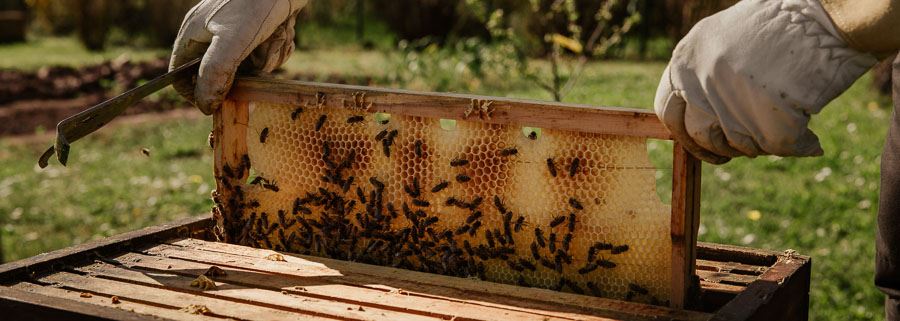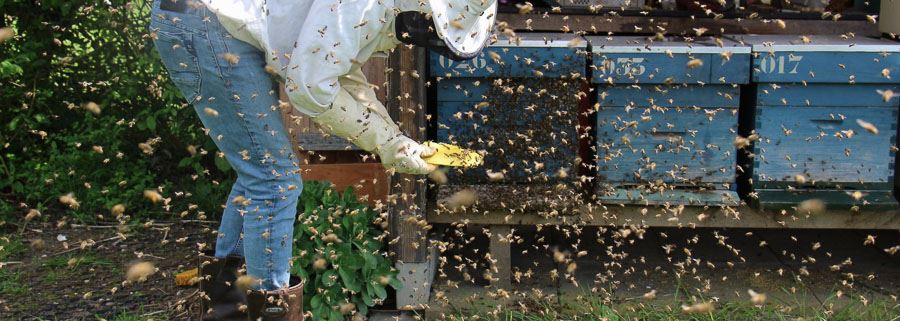So, you’re interested in beekeeping?
There are a number of reasons why you may be exploring the idea of keeping bees.
Although bees are wild animals and in the wild look after themselves, when kept in urban areas they need to be managed by a knowledgeable beekeeper, practising responsible hive management and swarm control. Beekeeping isn’t quite as simple as buying a ‘Flow hive,’ and turning on the tap to get honey. Bees are a livestock, and the keeping of bees in South Australia comes under the Livestock Act of SA. A great starting point are the 2 following guides;
We also have a number of excellent resources for beginners in our library. (A favourite is Robert Owens’, The Australian Beekeeping Manual.) Come along to a meeting to have a browse though our collection. Beekeeping might not be right for you
Beekeeping might not be a great fit for you. You’ll need plenty of time. Sometimes you’ll need to attend to the bees on their schedule instead of yours. You will get stung. There is a lot to learn before you can start. Biosecurity & Hive Registration
One of the responsibilities we have as beekeepers is to register our hives, and inspect them regularly, detect diseases and pests in the hive, report notifiable diseases. PIRSA have a page outlining the pests and diseases which hives in SA can be susceptible to. The Agrifutures Biosecurity Manual for Beekeepers is an excellent free PDF which outlines how to identify and deal with exotic and established pests that affect honey bees. The Australian Honey Bee Industry Biosecurity Code of Practice includes the following requirements for ALL beekeepers:
Find out more in the PIRSA guide Recreational Beekeeping, A guide to beekeeping in South Australia and in the Australian Honey Bee Industry Biosecurity Code of Practice. There are additional requirements for beekeepers with 20 hives or more and further for those with 50 hives or more. Acquiring bees
New beekeepers who are setting up their first hive usually find that getting equipment is relatively straight-forward: There are numerous on-line and traditional bricks-and-mortar retailers that sell equipment. But once the equipment is organised, the next question raises itself: Where do I get the bees? After you have made sure you can comply with local regulations and registered your hive, make sure you have personal protective equipment (i.e. bee suit and gloves) and a smoker. Also make sure your hive is assembled, painted and marked with your Hive Identification Code (issued by PIRSA) before you get your bees. Before getting your bees you will need to make sure you have picked out the location of your hive in your apiary. Once the bees are placed into position, the hive cannot be easily moved. Putting the hive under a tree that provides dappled shade is ideal. The hive should be elevated 30cm or more off the ground and away from ants. Choose your site carefully. Here are your options for getting bees. OPTION 1 - INSTALL A SWARMA swarm is a group of bees (usually collected by an experienced beekeeper) that has left their last hive to establish a new one. A swarm has a queen, but no eggs, no larvae and only the honey that the swarm carries in the bees’ stomachs. Starting a new hive with a swarm is often the cheapest way to acquire bees. Make contacts at the Beekeeping Society or through social media groups or by word of mouth to find someone who captures swarms and can provide a swarm to you. Some pest controllers will also provide swarms (although usually for a fee). Cold call, ask around and get on-line. To house the swarm, you will need to have prepared your own brood box, lid, base and frames of foundation. A small swarm will require a small box that holds 5 frames but a large swarm can go straight into an 8 or 10 frame brood box. The bees will usually come in whatever container was used to catch them and that needs to be emptied into your prepared brood box. If you need to collect the swarm from the catcher then you will need to be able to seal the entrance to your brood box. A swarm of angry bees flying around inside your car is exciting but not recommended. A rag wedged tightly into the entrance usually suffices. However, make sure that there are ventilation holes in the base or lid. Pros:
Cons:
OPTION 2 - BUY A NUCA nuc (pronounced ‘nuke’) is a small hive that usually consists of 5 frames of bees (and a queen!) and includes eggs, larvae and small amounts of stored nectar and pollen. Nucs can be purchased from sellers who can be contacted by:
In the interests of remaining vendor-neutral, I have not identified specific web-sites or social media. I recommend that you use the internet and social media search capabilities (Try: “Buy a nuc of bees”) to find relevant websites, social media groups and sellers. Make sure your bees are local: new beekeepers should not be in the bee import business. Beekeepers make nucs by splitting existing hives or capturing swarms and raising them until they have established. This means that you can be reasonably confident that you have a viable queen that is laying eggs. The beekeeper can also replace the queen with a young fresh queen of good stock to reduce the risk of getting a hive with undesirable characteristics. Typically you bring your brood box, lid and base to the beekeeper. The nuc is installed in your box and then you return and take delivery after sunset a day or two later (when all the foragers are back in the hive). If you put the 5-frame nuc into a larger 8 or 10 frame box then you will need additional frames for transport so that the nuc frames do not rattle around. And you will need to be able block the entrance for transportation. And did I mention ventilation holes? Pros:
Cons:
OPTION 3 - BUY A HIVEA third option is to buy a mature brood box. Their main advantage is that their large established population means that they will produce harvestable honey sooner. But their main disadvantage is their cost – advertised prices can be several times the cost of a nuc. Often new beekeepers will learn more by watching a swarm or nuc grow into a hive. But if you want to buy a complete hive, go for it! A Few Words to FinishPlease remember to be a responsible beekeeper. In Australia, you need to keep bio-security records that include recording the movements of bees. You must keep a record of the transportation from wherever you collected your bees back to your apiary. You have a few on-going obligations: to provide a source of water for your bees and you need to inspect hives regularly for diseases and record the inspections. If you are keeping bees in an urban setting, it’s also a good idea to open a dialogue with neighbours before you get your bees so that they do not feel that you have imposed your beekeeping on them. (“I’m thinking of getting bees. Does anyone in your house suffer any medical condition that makes the presence of bees risky to their health?”). You can also reduce the risk of bees getting into your neighbour’s hair (literally) by positioning hives away from the property boundary so that the bees are flying well-above head height by the time that they leave your property. And offering your neighbours the occasional jar of free honey never hurts ... Edited from Adrian Makarowsky’s ‘Got Bees?’ essay, Nov 2019 |





